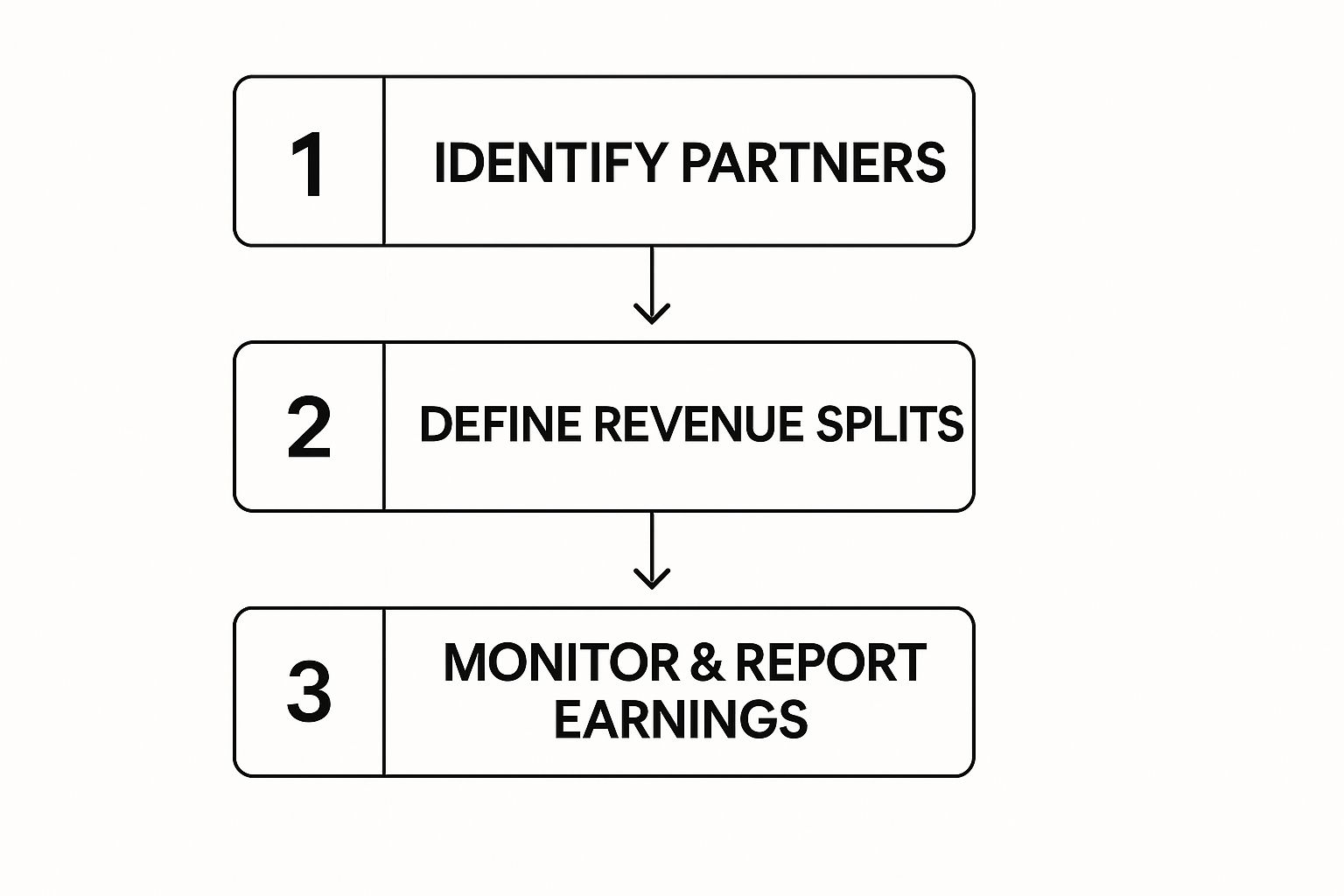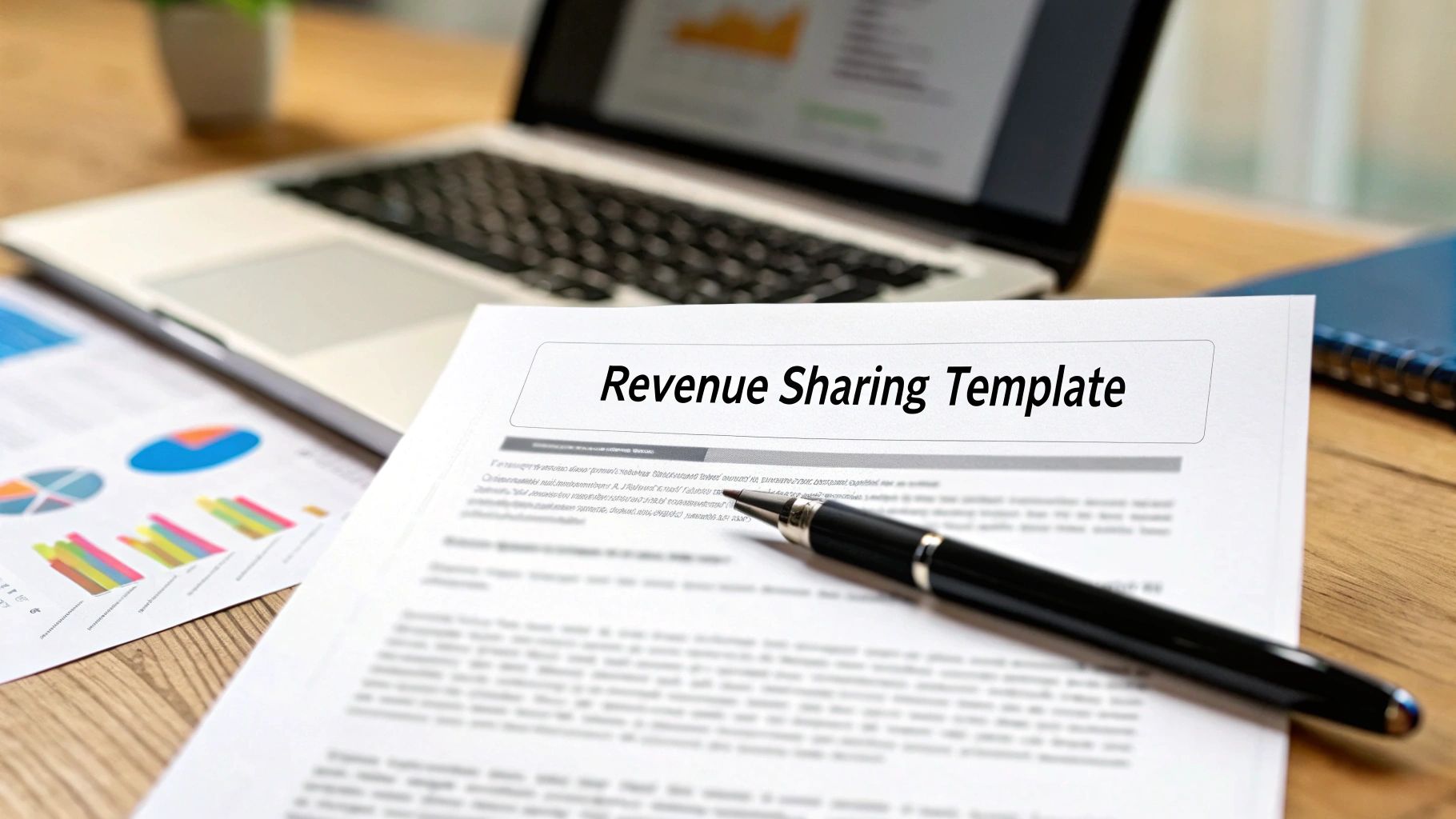A revenue sharing agreement is more than just a template; it’s a legally binding contract that spells out exactly how you and your partners will divide the gross income from a specific business venture. We’ve put together a free, downloadable template that gives you the essential framework to define these terms, making sure everyone involved is protected.
Getting to Grips With Revenue Sharing Agreements

Before you jump into any partnership, you need to understand what a revenue sharing agreement really is and why it's so critical for keeping everyone's goals aligned. Think of it as a formal document that specifies the exact percentages of top-line revenue each partner will get. This is a common setup for joint ventures, software partnerships, and even creator collaborations.
It’s easy to confuse this with profit sharing, but they are fundamentally different. Profit sharing carves up what's left after all the expenses are paid. Revenue sharing, on the other hand, focuses on the gross income—the total money coming in the door. This distinction is huge because it keeps the math simple and sidesteps messy arguments about what counts as a legitimate business expense.
A well-written agreement is basically the roadmap for your collaboration. It forces you to have the important conversations upfront, ensuring everyone is on the same page from the get-go. This builds trust and prevents the kind of misunderstandings that can poison a partnership down the road.
Why You Absolutely Need a Formal Agreement
Relying on a handshake deal is a recipe for disaster. Using a formal revenue sharing agreement template brings much-needed structure and clarity to your partnership, turning a casual arrangement into a defined business relationship with clear expectations.
Here’s why it’s a non-negotiable:
- Clarity on Contributions: The agreement documents who is responsible for what. This could be anything from the initial investment and marketing grunt work to ongoing operational tasks.
- Financial Transparency: It explicitly defines "revenue" and lays out the precise split. There’s no room for guessing games or creative interpretations later.
- Legal Protection: A signed contract is your safety net. It's legally enforceable and gives you a clear process for resolving disputes if things go south.
A strong agreement isn't about mistrust; it's about creating a foundation of clarity that allows a partnership to thrive. It proactively addresses potential friction points so you can focus on mutual growth.
Not all partnerships are the same, so your agreement shouldn't be either. For a closer look at different structures, you can explore several revenue sharing models to find one that fits your specific needs. This guide and our template will walk you through the most common and adaptable options.
To give you a head start, the table below provides a quick snapshot of the essential components you'll find in our template. It breaks down what each clause does and why it's crucial for creating a fair and solid deal for everyone.
Key Components of a Revenue Sharing Agreement
| Clause | Purpose & Key Considerations |
|---|---|
| Parties Involved | Clearly identifies all individuals or companies entering into the agreement. Get names and legal entities right. |
| Definition of Revenue | Crucially defines what income is subject to sharing. Be specific to prevent future disputes over what's included. |
| Distribution Formula | Specifies the exact percentage or tiered structure for splitting the revenue. This is the heart of the financial arrangement. |
| Payment Schedule | Outlines when and how payments will be made (e.g., monthly, quarterly, net-30). Consistency is key. |
| Term and Termination | Defines the agreement's duration and the conditions under which it can be ended by either party. |
| Dispute Resolution | Establishes a process for handling disagreements, such as mediation or arbitration, to avoid costly litigation. |
Having these core sections clearly defined from the outset is what separates successful, long-term partnerships from the ones that fall apart at the first sign of trouble.
Breaking Down the Core Contract Clauses
A good revenue sharing template gives you a starting point, but knowing what each clause really means is how you build an agreement that actually protects your partnership. Let's get past the legalese and talk about the nuts and bolts of the sections you'll be spending the most time on.
This infographic breaks down the journey of setting up a revenue share system into three straightforward stages.

Think of it as a roadmap: you define the terms, lock in the split, and then establish a transparent system for reporting and payments. Following this flow methodically is the key to getting it right from the start.
The Definition of Revenue Clause
If you only get one clause perfect, make it this one. Any gray area here is a recipe for a major fallout down the road. You need to pin down, with extreme precision, what counts as "revenue" in your specific venture. Are you splitting gross sales? Just the subscription fees? Or maybe the income from ad placements?
Be just as clear about what’s not included. I’ve seen partnerships sour over these details, so spell them out. Common carve-outs include:
- Refunds and Chargebacks: You can't share money that you had to give back to a customer.
- Taxes: Things like sales tax or VAT are just passing through your accounts on their way to the government—it's not your income.
- Shipping or Handling Fees: For physical products, these are operational costs, not profit centers.
Imagine a SaaS company working with a marketing agency. Their agreement might define revenue as "all collected monthly and annual subscription fees, less any payment processing fees and refunds issued within that same period." That’s airtight. To achieve this kind of clarity, having a good grasp of general contract drafting principles is incredibly helpful.
The Revenue Distribution Formula
Okay, you've defined the pot of money. Now, how do you split it? This is where you lay out the exact math.
A fixed percentage is the most common and simple model. For example, Party A gets 70%, and Party B gets 30%. This is great for straightforward partnerships where everyone's contribution stays pretty consistent.
For something more dynamic, a tiered model can work wonders. I once worked with a software developer who offered affiliates a 20% share on the first $10,000 in monthly sales. But for any revenue generated beyond that, the share jumped to 30%. It’s a brilliant way to incentivize your partners to push harder. We’re even seeing this in unexpected places; the recent NCAA settlement includes a model where athletes can receive up to 22% of average conference revenues, proving how flexible these structures can be.
My Two Cents: Your distribution model should be a direct reflection of the value and risk each partner is shouldering. If one person is fronting all the cash and the other is handling the marketing grind, a simple 50/50 split might not feel fair six months from now. A tiered or dynamic model often works better.
Payment Terms and Schedule
This last piece is all about the "how" and "when" of getting paid. This clause takes all the guesswork out of the money flow and keeps the relationship running smoothly. Don't leave it vague.
Make sure you clearly state:
- Payment Frequency: Are you settling up monthly? Quarterly? Monthly is a popular choice because it keeps cash flow predictable for everyone.
- Payment Deadline: Be specific. "Net-30" is standard language, meaning payment is due within 30 days after the accounting period closes.
- Payment Method: How will the money change hands? Will it be a direct bank transfer (ACH), PayPal, or through a payment gateway like Stripe?
Getting these terms right prevents awkward conversations and ensures everyone feels respected. It’s the practical stuff that makes a partnership last.
Making Your Agreement Work for Your Industry

A template is a great starting point, but let’s be real—the secret to a successful partnership lies in customizing your agreement to the realities of your industry. The way value, risk, and contributions are measured in one field can be completely different from another. Your contract has to reflect that.
What flies in a software joint venture will almost certainly crash and burn in a collaboration between two artists.
You have to get beyond just plugging in a percentage and really think about how value is actually created in your specific partnership. Sticking with a one-size-fits-all model is a recipe for misunderstanding and, frankly, a bad deal. When you take the time to tailor the agreement, you build a foundation that feels fair to everyone and actually motivates the right kind of work.
Software and SaaS Partnerships
In the tech world, partnerships often center on things like integrations, reselling, or co-marketing campaigns. A classic example is a SaaS company teaming up with another business that provides a cool new integration, adding a valuable feature to their platform.
When you’re drafting this agreement, you need to be razor-sharp about which revenue stream you're sharing. Are you only splitting the money from customers who use that specific integration? Or is it a piece of every new subscription you can trace back to your partner's marketing?
A common route is to offer a straight percentage of the monthly recurring revenue (MRR) from customers the partner brings in. For instance, the integration partner might get 15-25% of the subscription fees for any client they refer or who uses their feature.
A hard-won lesson: Be explicit about the "attribution window." Your contract needs to state exactly how long a sale or sign-up counts toward the partner's credit. This simple clause can save you from future headaches over who gets credit for a customer who saw a partner's ad but didn't sign up for three months.
Payment Processing and Fintech
The payments space is a volume game, and the agreements reflect that. When a software platform integrates a payment processor, it's not just getting a service—it's essentially becoming a new sales channel for that processor. The revenue share here is a tiny slice of a very big pie.
In this industry, it's common to see revenue sharing agreements that give the payment service provider somewhere between 1% to 5% of the total transaction value. That number can swing based on factors like the sheer volume of transactions and whether they’re providing extra services like advanced fraud detection.
Content Creators and Affiliate Marketing
For YouTubers, influencers, and bloggers, revenue sharing is all about ad splits, sponsorships, and affiliate sales. Here, the contribution isn't a cash investment; it's the creator's audience, reach, and creative horsepower. If two YouTubers make a video together, their agreement might be as simple as splitting the YouTube AdSense revenue 50/50 for that one video.
Affiliate marketing is a bit different but just as crucial. The agreement here is all about defining the commission a creator earns when they drive a sale. These are pure performance-based partnerships. In fact, our guide on building an affiliate agreement template is a perfect resource for this kind of deal. The core idea is always the same: the agreement has to precisely connect the reward to the revenue-generating action.
Structuring International and Supply Chain Deals
Taking a partnership across borders or weaving it into a complex supply chain adds layers of complexity that a standard revenue sharing agreement just can't handle. Suddenly, you're juggling currency conversions, different legal frameworks, and logistical headaches that demand a much more robust contract.
Imagine a U.S. company licensing its patented tech to a European distributor. A simple percentage split is a recipe for trouble. Exchange rates are constantly in flux, and a deal that looks fair one month can become completely lopsided the next.
The key is to build an adaptive agreement from the start. A static contract is brittle; you need one that can bend with market changes without breaking the partnership.
This is where dynamic clauses become your best friend. Instead of locking in a flat royalty rate, your revenue sharing agreement template needs the flexibility to adjust based on these external factors.
Navigating Global Partnerships
When you're dealing with international patent licensing, your agreement has to tackle challenges like fluctuating exchange rates and wildly different regulatory environments head-on. Many experienced partners use a phased royalty approach. They might start with lower payments during the initial market entry phase and then ramp them up as sales gain traction.
This can also be tiered by region. It’s common to see higher percentages in mature markets like Europe and lower ones in emerging economies to balance out the risk. You can find some excellent examples of these intricate revenue sharing models for patents and how they manage risk effectively.
To keep currency risk from sinking your deal, you have a few solid options:
- Fix the Exchange Rate: Lock in a specific exchange rate for an entire reporting period, like a quarter. This gives both sides a predictable financial target.
- Use a Currency Collar: This is a bit more sophisticated. You set a floor and a ceiling for the exchange rate. If the real rate drifts outside this "collar," the revenue calculation gets adjusted, shielding everyone from extreme swings.
- Pay in a Single Currency: Simply designate one currency (usually USD) for all payments. This puts the burden of conversion squarely on the paying party.
Aligning the Supply Chain
Revenue sharing is also a fantastic tool for getting suppliers, manufacturers, and retailers all pulling in the same direction. In a traditional setup, a manufacturer sells to a retailer at a wholesale price, and that’s where their financial stake ends. The retailer is left holding all the risk of actually selling the product.
A revenue sharing model completely changes that dynamic. The manufacturer might agree to a lower upfront wholesale price in return for a cut of the final retail sale. This shared risk and reward system gives everyone a powerful incentive to work together toward the real goal: selling more product. The manufacturer is now motivated to create a top-notch item customers will want, and the retailer is driven to market it aggressively.
When you're putting these kinds of deals together, it pays to look at the bigger financial picture. Exploring related concepts like supply chain finance can uncover other ways to boost cash flow and create stability for everyone involved. Taking this holistic view is what builds a truly resilient and profitable supply chain.
Common Pitfalls and How to Avoid Them

A revenue sharing agreement is only as solid as its weakest clause. I’ve seen it happen time and again: even with a great template, a few common oversights can turn a promising partnership into a painful dispute. By paying close attention to a couple of key areas, you can sidestep these issues from the get-go.
One of the most common mistakes I see is a fuzzy definition of "revenue." When the terms are vague, you're creating loopholes that practically invite financial disagreements later on. It's not enough to just write "revenue"; you have to get granular and spell out exactly what it means for your specific deal.
Beyond the numbers, unclear roles and responsibilities can create just as much chaos. When no one’s sure who’s on the hook for marketing, who’s handling customer support, or who’s managing the tech, important tasks inevitably fall through the cracks. Your revenue sharing agreement template needs to be more than a financial document—it should be a clear map of who does what.
Vague Definitions and Fuzzy Math
Let’s be blunt: the single biggest source of conflict in these agreements is a poorly defined revenue clause. If you and your partner have different interpretations of what money gets put into the pot, you're already on a collision course.
Here’s a real-world scenario. Imagine a SaaS company teams up with a marketing influencer. The influencer thinks they're getting a percentage of every single sale the company makes during their campaign. But the company only intended to share revenue from new subscriptions that came directly from the influencer's unique coupon code. Without that spelled out in black and white, both sides are heading for a nasty surprise.
To prevent this nightmare, your agreement must be crystal clear.
- What’s In: Be explicit. For example, "Gross Revenue shall be defined as all subscription fees collected from customers."
- What’s Out: Be just as explicit about deductions. For instance, "Revenue shall not include any sales taxes, payment processing fees, or refunded amounts."
This level of detail is non-negotiable for preventing arguments over money. Beyond just the agreement, it's also about good financial hygiene. Proactively managing financial risk to stop revenue leakage is crucial to ensure the revenue you've agreed to share is tracked and protected accurately.
Neglecting an Exit Strategy
Nobody goes into a partnership thinking about how it will end, but failing to plan for a potential breakup is a rookie mistake. What happens if a partner wants out? What if your business goals diverge, or the venture just isn’t profitable? Without a pre-defined exit strategy, ending the partnership can become a legal and financial mess.
Think of your agreement as a business prenup. It absolutely needs a termination clause that outlines the specific conditions under which either party can dissolve the partnership.
Pro Tip: Don't just list the reasons for termination; detail the process. You need to specify things like notice periods (a 30 or 60-day written notice is standard), how the final payments will be calculated and paid out, and what happens to shared assets like customer lists or intellectual property.
This foresight provides a clean, fair off-ramp that can preserve your relationship and protect your business if things don't work out. It’s also smart to think about how you will continue to manage your affiliate program or other partnerships during a transition. A clear plan here means your operations won’t grind to a halt.
By anticipating these common pitfalls—ambiguous definitions and a missing exit plan—you can elevate a basic template into a powerful, conflict-resistant agreement. This builds trust from day one and gives your partnership the foundation it needs to succeed.
Answering Your Top Questions
When you're hammering out the details of a partnership, that's when the real questions start to surface. Let's get into the nitty-gritty of what people most often ask when putting together a revenue sharing agreement.
What’s a Fair Revenue Sharing Percentage?
Honestly, there’s no magic number. A "fair" split is less about an industry standard and more about the specific value each partner brings to the collaboration. It all comes down to contributions, risks, and ongoing effort.
Think about it this way: someone putting up all the initial cash and running the marketing is taking on more risk and doing more heavy lifting than a partner who contributes a one-time service. Their share should reflect that.
The best approach is to have a frank conversation about what each person’s contribution is truly worth. Write it all down, hash it out, and land on a split that everyone feels good about because it accurately mirrors the partnership's reality.
Is a Revenue Sharing Agreement Actually Legally Binding?
Yes, it absolutely is. As long as it's put together properly and signed by everyone involved, a revenue sharing agreement is a fully enforceable legal contract. For it to be solid, it needs a few core components:
- Clear Terms: The agreement can't be vague. It has to spell everything out in unambiguous language.
- Consideration: This is a legal term, but it's simple: it just means everyone is giving something and getting something of value in return.
- Mutual Assent: All partners must willingly agree to the terms, which is typically shown by signing on the dotted line.
Our template gives you a fantastic starting point. But, I always recommend having a lawyer give the final document a once-over. It’s a small investment that can save you a world of headaches and ensure it’s completely ironclad.
A good contract isn't there to start a fight—it's there to prevent one. Getting it all in writing creates a roadmap that protects everyone and shows you exactly what to do if you ever disagree.
How Is This Different from a Profit Sharing Agreement?
The key distinction is what you’re actually splitting.
A revenue sharing agreement is all about the top-line number—the total amount of money that comes in before a single expense is taken out. A profit sharing agreement, on the other hand, carves up the bottom-line profit, which is whatever is left after you’ve paid for everything.
Revenue sharing is often much simpler and cleaner. You avoid the potential arguments over what counts as a legitimate business expense, which can get messy.
This straightforward model is so effective that it’s used to streamline even highly complex business operations. For example, extensive research has shown that well-designed revenue-sharing contracts can dramatically improve supply chain efficiency compared to older pricing models because they distribute risk more intelligently. You can dive into the full research on contract effectiveness to see these principles in action across different industries.
This kind of clarity makes revenue sharing a powerful choice for all sorts of partnerships, from a simple two-person venture to a sophisticated global supply chain.
Ready to build your partnership on a foundation of clarity and trust? Refgrow provides the tools to launch, manage, and scale your affiliate and referral programs seamlessly. Get started in minutes and create a custom, native affiliate experience for your SaaS product. Launch your program with Refgrow today.

